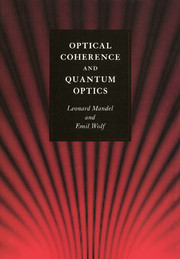Book contents
- Frontmatter
- Contents
- Preface
- 1 Elements of probability theory
- 2 Random (or stochastic) processes
- 3 Some useful mathematical techniques
- 4 Second-order coherence theory of scalar wavefields
- 5 Radiation from sources of any state of coherence
- 6 Second-order coherence theory of vector electromagnetic fields
- 7 Some applications of second-order coherence theory
- 8 Higher-order correlations in optical fields
- 9 Semiclassical theory of photoelectric detection of light
- 10 Quantization of the free electromagnetic field
- 11 Coherent states of the electromagnetic field
- 12 Quantum correlations and photon statistics
- 13 Radiation from thermal equilibrium sources
- 14 Quantum theory of photoelectric detection of light
- 15 Interaction between light and a two-level atom
- 16 Collective atomic interactions
- 17 Some general techniques for treating interacting systems
- 18 The single-mode laser
- 19 The two-mode ring laser
- 20 The linear light amplifier
- 21 Squeezed states of light
- 22 Some quantum effects in nonlinear optics
- References
- Author index
- Subject index
22 - Some quantum effects in nonlinear optics
Published online by Cambridge University Press: 05 April 2013
- Frontmatter
- Contents
- Preface
- 1 Elements of probability theory
- 2 Random (or stochastic) processes
- 3 Some useful mathematical techniques
- 4 Second-order coherence theory of scalar wavefields
- 5 Radiation from sources of any state of coherence
- 6 Second-order coherence theory of vector electromagnetic fields
- 7 Some applications of second-order coherence theory
- 8 Higher-order correlations in optical fields
- 9 Semiclassical theory of photoelectric detection of light
- 10 Quantization of the free electromagnetic field
- 11 Coherent states of the electromagnetic field
- 12 Quantum correlations and photon statistics
- 13 Radiation from thermal equilibrium sources
- 14 Quantum theory of photoelectric detection of light
- 15 Interaction between light and a two-level atom
- 16 Collective atomic interactions
- 17 Some general techniques for treating interacting systems
- 18 The single-mode laser
- 19 The two-mode ring laser
- 20 The linear light amplifier
- 21 Squeezed states of light
- 22 Some quantum effects in nonlinear optics
- References
- Author index
- Subject index
Summary
Introduction
We have already encountered situations in which light of one frequency falling on an atomic system gives rise to light of different frequencies (cf. Section 15.6). The atom may here be considered to play the role of a (noisy) nonlinear transducer for the incident field. Even stronger nonlinear effects arise when one is dealing with a large number of atoms, or a nonlinear medium. Under these circumstances it is sometimes permissible to ignore the atomic structure and to treat the medium as a continuum, as in Maxwell's electromagnetic theory. The subject of the interaction of the incident field with the nonlinear medium is usually known as nonlinear optics.
The subject had its beginnings in an experiment in which a strong beam of red light (wavelength 6943 Å) from a ruby laser was allowed to fall on a quartz crystal, and a faint beam of blue light at a wavelength of 3472 Å, the first harmonic of the red, was produced (Franken, Hill, Peters and Weinreich, 1961). The development of the subject of nonlinear optics into a mature field is due largely to the work of Bloembergen and his collaborators. In the following we shall consider only a few simple illustrative examples of phenomena in nonlinear optics. More topics and more detail can be found in the books by Bloembergen and others (Bloembergen, 1965; Yariv, 1967, Chap. 21; Shen, 1984; Schubert and Wilhelmi, 1986; Butcher and Cotter, 1990; Boyd, 1992).
- Type
- Chapter
- Information
- Optical Coherence and Quantum Optics , pp. 1069 - 1108Publisher: Cambridge University PressPrint publication year: 1995
- 3
- Cited by



